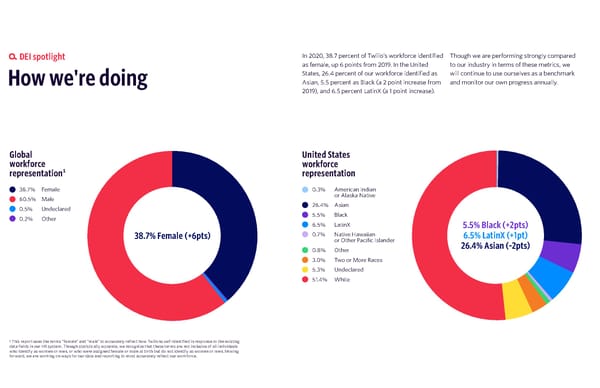DEI spotlight In 2020, 38.7 percent of Twilio’s workforce identified Though we are performing strongly compared as female, up 6 points from 2019. In the United to our industry in terms of these metrics, we States, 26.4 percent of our workforce identified as will continue to use ourselves as a benchmark How we're doing Asian, 5.5 percent as Black (a 2 point increase from and monitor our own progress annually. 2019), and 6.5 percent LatinX (a 1 point increase). Global United States workforce workforce representation¹ representation 38.7% Female 0.3% American Indian 60.5% Male or Alaska Native 0.5% Undeclared 26.4% Asian 0.2% Other 5.5% Black 6.5% LatinX 5.5% Black (+2pts) 38.7% Female (+6pts) 0.7% Native Hawaiian 6.5% LatinX (+1pt) or Other Pacific Islander 26.4% Asian (-2pts) 0.8% Other 3.0% Two or More Races 5.3% Undeclared 51.4% White 1 This report uses the terms "female" and "male" to accurately reflect how Twilions self-identified in response to the existing data fields in our HR system. Though statistically accurate, we recognize that these terms are not inclusive of all individuals who identify as women or men, or who were assigned female or male at birth but do not identify as women or men. Moving forward, we are working on ways for our data and reporting to most accurately reflect our workforce.
 Twilio Impact Report Page 34 Page 36
Twilio Impact Report Page 34 Page 36